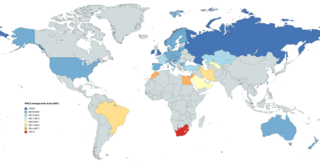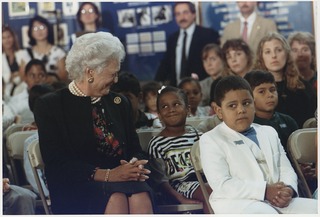Related Research Articles
Whole language is a philosophy of reading and a discredited educational method originally developed for teaching literacy in English to young children. The method became a major model for education in the United States, Canada, New Zealand, and the UK in the 1980s and 1990s, despite there being no scientific support for the method's effectiveness. It is based on the premise that learning to read English comes naturally to humans, especially young children, in the same way that learning to speak develops naturally.

Phonics is a method for teaching reading and writing to beginners. To use phonics is to teach the relationship between the sounds of the spoken language (phonemes), and the letters (graphemes) or groups of letters or syllables of the written language. Phonics is also known as the alphabetic principle or the alphabetic code. It can be used with any writing system that is alphabetic, such as that of English, Russian, and most other languages. Phonics is also sometimes used as part of the process of teaching Chinese people to read and write Chinese characters, which are not alphabetic, using pinyin, which is alphabetic.
Reading for special needs has become an area of interest as the understanding of reading has improved. Teaching children with special needs how to read was not historically pursued due to perspectives of a Reading Readiness model. This model assumes that a reader must learn to read in a hierarchical manner such that one skill must be mastered before learning the next skill. This approach often led to teaching sub-skills of reading in a decontextualized manner. This style of teaching made it difficult for children to master these early skills, and as a result, did not advance to more advanced literacy instruction and often continued to receive age-inappropriate instruction.
A KWL table, or KWL chart, is a graphical organizer designed to help in learning. The letters KWL are an acronym, for what students, in the course of a lesson, already know, want to know, and ultimately learn. It is a part of the constructivist teaching method where students move away from what are considered traditional methods of teaching and learning. In this particular methodology the students are given the space to learn by constructing their own learning pace and their own style of understanding a given topic or idea. The KWL chart or table was developed within this methodology and is a form of instructional reading strategy that is used to guide students taking them through the idea and the text. A KWL table is typically divided into three columns titled Know, Want and Learned. The table comes in various forms as some have modified it to include or exclude information.

Synthetic phonics, also known as blended phonics or inductive phonics, is a method of teaching English reading which first teaches letter-sounds and then how to blend (synthesise) these sounds to achieve full pronunciation of whole words.

The IEA's Progress in International Reading Literacy Study (PIRLS) is an international study of reading (comprehension) achievement in 9-10 year olds. It has been conducted every five years since 2001 by the International Association for the Evaluation of Educational Achievement (IEA). It is designed to measure children's reading literacy achievement, to provide a baseline for future studies of trends in achievement, and to gather information about children's home and school experiences in learning to read.
Adolescent literacy refers to the ability of adolescents to read and write. Adolescence is a period of rapid psychological and neurological development, during which children develop morally, cognitively, and socially. All of these three types of development have influence—to varying degrees—on the development of literacy skills.
Kari-Lynn Winters, née Moore is a Canadian children's author, playwright, drama educator, and literacy professor. She taught children's literacy, literature, dance and drama education at the University of British Columbia from 2004 to 2009. In 2010, Winters became an assistant professor in the Faculty of Education at Brock University (Ontario) and co-editor of Teaching and Learning. She advanced to associate professor in 2014, and to full professor in 2021.
Reciprocal teaching is a powerful instructional method designed to foster reading comprehension through collaborative dialogue between educators and students. Rooted in the work of Annemarie Palincsar, this approach aims to empower students with specific reading strategies, such as Questioning, Clarifying, Summarizing, and Predicting, to actively construct meaning from text.

Literacy in the United States was categorized by the National Center for Education Statistics into different literacy levels, with 92% of American adults having at least "Level 1" literacy in 2014. Nationally, over 20% of adult Americans have a literacy proficiency at or below Level 1. Adults in this range have difficulty using or understanding print materials. Those on the higher end of this category can perform simple tasks based on the information they read, but adults below Level 1 may only understand very basic vocabulary or be functionally illiterate. According to a 2020 report by Gallup based on data from the U.S. Department of Education, 54% of adults in the United States lack English literacy proficiency.

Reading is the process of taking in the sense or meaning of symbols, often specifically those of a written language, by means of sight or touch.
Anne Haas Dyson is a professor at the University of Illinois. Her fields are the study of literacy, pedagogy, and contemporary, diverse childhoods. Using qualitative and sociolinguistic research procedures, Dyson examines the use of written language from children's perspectives within their social worlds, and as they engage with popular culture. Books she has published include The Brothers and Sisters Learn to Write, Popular Literacies in Childhood and School Cultures (2003), Writing Superheroes, Contemporary Childhood, Popular Culture, and Classroom Literacy (1997), Social Worlds of Children Learning to Write in an Urban Primary School (1993), Multiple Worlds of Child Writers: Friends Learning to Write (1989). Dyson has also written articles for professional journals.
Elfrieda "Freddy" Hiebert is an educational researcher whose work examines literacy, learning, early childhood development, teacher development, writing and children's literature. The main thrust of her work addresses literacy learning among at-risk youth in American classrooms. Currently, she is the CEO and president of TextProject, Inc., an agency that is dedicated to bringing beginning and struggling readers to high levels of literacy through a variety of strategies and tools, particularly through using science and social studies texts, used for reading instruction.

Douglas K. Hartman is an American scholar in the field of education. He is a professor of technology & human learning in the College of Education at Michigan State University. He has a joint appointment in the Departments of Educational Psychology & Educational Technology and Teacher Education. His research focuses on the use of digital technologies for human learning in a number of domains.
Concept-Oriented Reading Instruction (CORI) was developed in 1993 by Dr. John T. Guthrie with a team of elementary teachers and graduate students. The project designed and implemented a framework of conceptually oriented reading instruction to improve students' amount and breadth of reading, intrinsic motivations for reading, and strategies of search and comprehension. The framework emphasized five phases of reading instruction in a content domain: observing and personalizing, searching and retrieving, comprehending and integrating, communicating to others, and interacting with peers to construct meaning. CORI instruction was contrasted to experience-based teaching and strategy instruction in terms of its support for motivational and cognitive development.
Patricia A. Edwards, a member of the Reading Hall of Fame, is a Distinguished Professor of Language and Literacy in the Department of Teacher Education and a Senior University Outreach Fellow at Michigan State University. She is a nationally and internationally recognized expert in parent involvement, home-school-community partnerships, and multicultural, early, and family/intergenerational literacy with a focus on poor and minority children. She served on the International Literacy Association Board of Directors from 1998–2001, as the first African American President of the Literacy Research Association from 2006–2007, and as President of the International Literacy Association from 2010–2011. Edwards also served as a member of the Board of Directors for the American Educational Research Association's (AERA) Family, School, and Community Partnerships Special Interest Group (SIG) from 2014–2016 and was elected to serve as its President-Elect/President from 2016–2020.
Gay Su Pinnell is an American educational theorist and a professor emerita at the School of Teaching and Learning at the Ohio State University. She is best known for her work with Irene Fountas on literacy and guided reading, a teaching framework that laid the groundwork for the Fountas and Pinnell reading levels.
Carol McDonald Connor was an educational psychologist known for her research contributions to the field of early literacy development in diverse learners, in particular for work on individualized student instruction interventions and the lattice model of reading development. She held the position of Chancellor's Faculty and Equity Advisor in the School of Education at the University of California, Irvine.

Timothy Shanahan is an educator, researcher, and education policy-maker focused on literacy education. He is Distinguished Professor Emeritus in Education, at the University of Illinois at Chicago, College of Education, Department of Curriculum & Instruction, and he has held a visiting research appointment at Queens University, Belfast, Northern Ireland. He was elected president of the International Literacy Association in 2004. He operates the popular informational website, Shanahan on Literacy. He was recently recognized as one of the top 2% of scientists in the world, according to a recent study published by Stanford University scholars.
Annemarie Sullivan Palincsar is a scholar of education known for her research on literacy instruction, reciprocal teaching, and cognitive apprenticeships. Her involvement in the National Academies of Sciences, Engineering, and Medicine Research Council on the Prevention of Reading Difficulty in Young Children, the National Research Council's Panel on Teacher Preparation, and the International Literacy Association's Literacy Research Panel, attests to her dedication to advancing educational research and improving teacher training. Palincsar is the Ann L. Brown Distinguished University Professor Emerita at the Marsal Family School of Education at the University of Michigan.
References
- ↑ Duke, N. K. (2000). 3.6 minutes per day: The scarcity of informational texts in first grade. Reading Research Quarterly, 35, 202-224.
- ↑ Duke, N. K. (2000). For the rich it’s richer: Print experiences and environments offered to children in very low- and very high-SES first grade classrooms. American Educational Research Journal, 37, 441-478.
- ↑ "Google Scholar".
- ↑ Duke (2004). The case for informational text. Educational Leadership 61(6) 40-44.
- ↑ Duke, N.K., & Mallette, M.H. (Eds.) (2004). Literacy research methodologies. New York: Guilford Press. Duke, N. K., & Mallette, M. H. (Eds.) (2011). Literacy research methodologies (2nd ed.). New York: Guilford Press.
- ↑ Duke, N. K., Pearson, P. D., Strachan, S. L., & Billman, A. K. (2011). Essential elements of fostering and teaching reading comprehension. In S. J. Samuels & A. E. Farstrup (Eds.), What research has to say about reading instruction (4th ed.) (pp. 51-93). Newark, DE: International Reading Association.
- ↑
- Duke, N. K., & Beck, S. W. (1999). Education should consider alternative formats for the